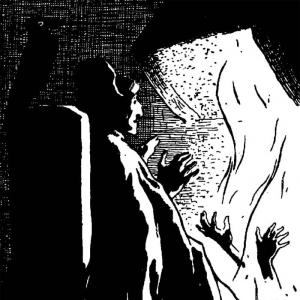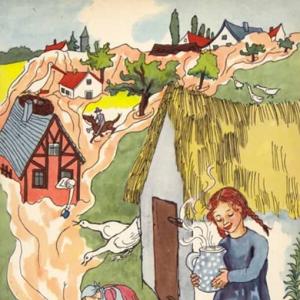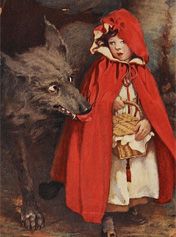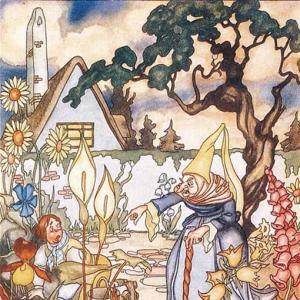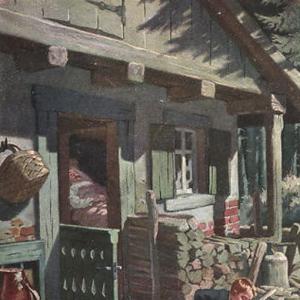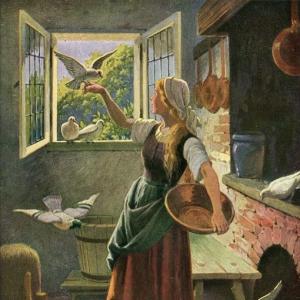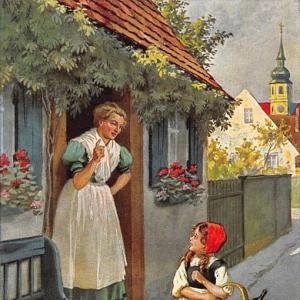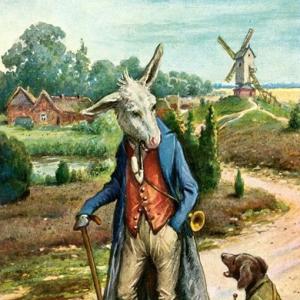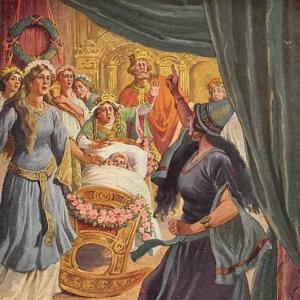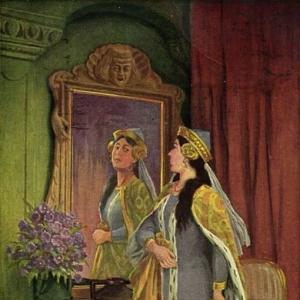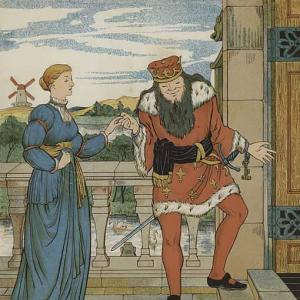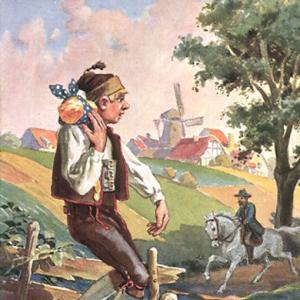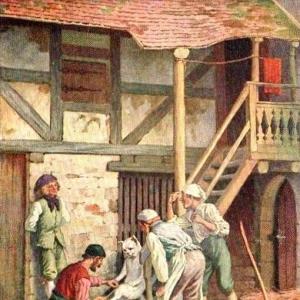Reading time for children: 10 min
A prize, or rather two prizes, a great one and a small one, had been awarded for the greatest swiftness in running,– not in a single race, but for the whole year.
„I obtained the first prize,“ said the hare. „Justice must still be carried out, even when one has relations and good friends among the prize committee; but that the snail should have received the second prize, I consider almost an insult to myself“
„No,“ said the fence-rail, who had been a witness at the distribution of prizes; „there should be some consideration for industry and perseverance. I have heard many respectable people say so, and I can quite understand it. The snail certainly took half a year to get over the threshold of the door; but he injured himself, and broke his collar-bone by the haste he made. He gave himself up entirely to the race, and ran with his house on his back, which was all, of course, very praiseworthy; and therefore he obtained the second prize.“
„I think I ought to have had some consideration too,“ said the swallow. „I should imagine no one can be swifter in soaring and flight than I am; and how far I have been! far, far away.“
„Yes, that is your misfortune,“ said the fence-rail; „you are so fickle, so unsettled. You must always be travelling about into foreign lands when the cold commences here. You have no love of fatherland in you. There can be no consideration for you.“
„But now, if I have been lying the whole winter in the moor,“ said the swallow, „and suppose I slept the whole time, would that be taken into account?“
„Bring a certificate from the old moor-hen,“ said he, „that you have slept away half your time in fatherland. Then you will be treated with some consideration.“
„I deserved the first prize, and not the second,“ said the snail. „I know so much, at least, that the hare only ran from cowardice, and because he thought there was danger in delay. I, on the other hand, made running the business of my life, and have become a cripple in the service. If any one had a first prize, it ought to have been myself. But I do not understand chattering and boasting. On the contrary, I despise it.“ And the snail spat at them with contempt.
„I am able to affirm with word of oath, that each prize– at least, those for which I voted– was given with just and proper consideration,“ said the old boundary post in the wood, who was a member of the committee of judges. „I always act with due order, consideration, and calculation. Seven times have I already had the honor to be present at the distribution of the prizes, and to vote; but today is the first time I have been able to carry out my will. I always reckon the first prize by going through the alphabet from the beginning, and the second by going through from the end. Be so kind as to give me your attention, and I will explain to you how I reckon from the beginning. The eighth letter from A is H, and there we have H for hare; therefore I awarded to the hare the first prize. The eighth letter from the end of the alphabet is S, and therefore the snail received the second prize. Next year, the letter I will have its turn for the first prize, and the letter R for the second.“
„I should really have voted for myself,“ said the mule, „if I had not been one of the judges on the committee. Not only the rapidity with which advance is made, but every other quality should have due consideration; as, for instance, how much weight a candidate is able to draw; but I have not brought this quality forward now, nor the sagacity of the hare in his flight, nor the cunning with which he suddenly springs aside and doubles, to lead people on a false track, thinking he has concealed himself. No. There is something else on which more stress should be laid, and which ought not be left unnoticed. I mean that which mankind call the beautiful. It is on the beautiful that I particularly fix my eyes. I observed the well-grown ears of the hare. It is a pleasure to me to observe how long they are. It seemed as if I saw myself again in the days of my childhood; and so I voted for the hare.“
„Buz,“ said the fly; „there, I’m not going to make a long speech; but I wish to say something about hares. I have really overtaken more than one hare, when I have been seated on the engine in front of a railway train. I often do so. One can then so easily judge of one’s own swiftness. Not long ago, I crushed the hind legs of a young hare. He had been running a long time before the engine. He had no idea that I was travelling there. At last he had to stop in his career, and the engine ran over his hind legs, and crushed them. For I set upon it. I left him lying there, and rode on farther. I call that conquering him; but I do not want the prize.“
„It really seems to me,“ thought the wild rose, though she did not express her opinion aloud– it is not in her nature to do so,– though it would have been quite as well if she had; „it certainly seems to me that the sunbeam ought to have had the honor of receiving the first prize. The sunbeam flies in a few minutes along the immeasurable path from the sun to us. It arrives in such strength, that all nature awakes to loveliness and beauty. We roses blush and exhale fragrance in its presence. Our worshipful judges don’t appear to have noticed this at all. Were I the sunbeam, I would give each one of them a sun stroke; but that would only make them mad, and they are mad enough already. I only hope,“ continued the rose, „that peace may reign in the wood. It is glorious to bloom, to be fragrant, and to live; to live in story and in song. The sunbeam will outlive us all.“
„What is the first prize?“ asked the earthworm, who had overslept the time, and only now came up.
„It contains a free admission to a cabbage-garden,“ replied the mule. „I proposed that as one of the prizes. The hare most decidedly must have it; and I, as an active and thoughtful member of the committee, took especial care that the prize should be one of advantage to him. So now he is provided for. The snail can now sit on the fence, and lick up moss and sunshine. He has also been appointed one of the first judges of swiftness in racing. It is worth much to know that one of the numbers is a man of talent in the thing men call a ‚committee.‘ I must say I expect much in the future. We have already made such a good beginning.“
 Learn languages. Double-tap on a word.Learn languages in context with Childstories.org and Deepl.com.
Learn languages. Double-tap on a word.Learn languages in context with Childstories.org and Deepl.com.Backgrounds
Interpretations
Adaptions
Summary
Linguistics
„The Races“ is a fairy tale by Hans Christian Andersen, a Danish author who lived between 1805 and 1875. Andersen is best known for his contributions to children’s literature, having written numerous fairy tales that have become classics, such as „The Little Mermaid,“ „The Ugly Duckling,“ „The Emperor’s New Clothes,“ and „The Snow Queen.“ Many of his stories contain moral lessons and have been adapted into various forms of media, such as films, plays, and ballets.
Andersen’s stories often include anthropomorphic animals and objects as characters, which allows him to explore human themes and emotions from a different perspective. In „The Races,“ animals and objects are personified and given human-like qualities, such as pride, ambition, and jealousy. This approach helps the reader to relate to the story and better understand the underlying messages and themes.
„The Races“ was first published in 1851 as part of Andersen’s collection of fairy tales called „New Fairy Tales.“ This collection also includes other well-known stories like „The Shadow“ and „The Snowman.“ Like many of his other works, „The Races“ presents life lessons and insights into human nature through the experiences of its characters.
„The Races“ by Hans Christian Andersen can be interpreted in various ways, touching on themes such as the subjective nature of awards, the importance of perseverance and hard work, and the value of different qualities in different contexts.
Subjectivity of awards: The story highlights how the criteria for winning a prize can be arbitrary or biased. The alphabetical system used by the old boundary post and the personal preferences of the mule demonstrate that the judgments made may not be entirely fair or accurate. This can serve as a reminder that awards and recognition should be taken with a grain of salt, as they may not always reflect true merit.
Perseverance and hard work: The snail’s slow pace but unwavering dedication to the race emphasizes the importance of perseverance and effort, regardless of one’s natural abilities. This can be a lesson in valuing determination and hard work over natural talent or speed.
Different qualities valued in different contexts: The story illustrates that different qualities can be valued in different situations. While the hare’s speed and the snail’s perseverance are rewarded, other qualities like the swallow’s loyalty to its homeland and the sunbeam’s ability to inspire beauty are overlooked. This can teach readers that everyone has unique qualities that may be valued differently, and that it’s essential to recognize and appreciate the diversity of skills and attributes that individuals possess.
The danger of pride and arrogance: The hare’s initial reaction to the snail receiving the second prize highlights the potential pitfalls of pride and arrogance. The hare feels insulted by the snail’s recognition, unable to see the value in the snail’s perseverance. This theme can serve as a reminder to stay humble and appreciate the achievements of others, even if they are different from our own.
The importance of inner beauty and appreciating the simple things: The wild rose’s reflections on the sunbeam’s impact on nature’s beauty emphasize the importance of inner beauty and the simple things in life. In a world where external achievements and recognition are often valued more than inner qualities, this story encourages readers to appreciate the smaller and often overlooked aspects of life that can bring joy and beauty.
„The Races,“ also known as „The Steadfast Tin Soldier,“ is a popular fairy tale by Hans Christian Andersen that has inspired numerous adaptations in various forms of media. Here are some notable adaptations:
Animated Films: Several animated films have been made based on „The Races,“ including a 1948 Russian adaptation and a 1992 Japanese anime version titled „The Brave Tin Soldier.“ There have also been several shorter animated adaptations, such as a 1955 Disney short film and a 1970 British television special.
Stage Productions: „The Races“ has been adapted for the stage in various forms, including puppet shows, ballets, and musicals. One notable adaptation is the 2007 Off-Broadway musical „The Steadfast Tin Soldier,“ which features music by the indie rock band The Lobbyists.
Literature: „The Races“ has inspired numerous adaptations in literature, including children’s books and graphic novels. Notable examples include „The Brave Tin Soldier“ by Mary Hays Weik, „The Steadfast Tin Soldier“ by Jane Yolen, and „The Tin Soldier“ by Russell Hoban.
Films: In addition to animated adaptations, „The Races“ has also been adapted into live-action films, such as the 1955 Soviet film „The Steadfast Tin Soldier“ and the 2007 Russian film „The Brave Tin Soldier.“
Video Games: „The Races“ has even inspired video game adaptations, such as the 2011 mobile game „The Steadfast Tin Soldier“ and the 2016 puzzle game „Tinertia,“ which features a protagonist based on the tin soldier from the fairy tale.
Overall, „The Races“ has proven to be a versatile and enduring story that has inspired adaptations in many different forms of media.
In Hans Christian Andersen’s fairy tale „The Races,“ various animals are awarded prizes for their swiftness throughout the year. The hare wins the first prize, while the snail receives the second. The hare is upset that the snail, who took half a year to cross a threshold, is even considered for an award. The fence-rail, a witness to the award distribution, argues that industry and perseverance should be recognized, citing the snail’s effort and dedication despite his slow pace.
The swallow, who is known for its swift flight, questions why it didn’t receive any consideration. The fence-rail dismisses the swallow’s concerns due to its migratory habits and lack of loyalty to its homeland. The snail, on the other hand, believes it should have received the first prize and dismisses the hare’s victory as mere cowardice. The old boundary post, a judge, explains the rationale behind the awards based on an alphabetical system, which will change with each passing year.
The mule, another judge, believes it should have voted for itself but focused on the hare’s beauty and long ears, reminiscent of its own youth. The fly shares its experience of overtaking hares on a train, though it doesn’t seek a prize. The wild rose silently thinks the sunbeam should have won the first prize due to its speed and ability to inspire beauty in nature. The earthworm, who missed the award announcements, learns that the first prize includes free admission to a cabbage garden, while the snail has been appointed as a judge of racing. The mule believes this is a good beginning and expects more positive developments in the future.
Hans Christian Andersen’s fairy tale „The Races“ is a satirical allegory that critiques societal norms and perceptions of merit and achievement. Through a whimsical narrative, Andersen explores themes of fairness, the subjective nature of success, and the arbitrary methods by which accolades are often bestowed.
Character Analysis
The Hare: Represents traditional notions of speed and success. He embodies the expectations of society where swiftness and visible achievements are rewarded.
The Snail: Symbolizes perseverance and dedication. Although mocked by characters like the Hare, the Snail’s slow and steady progress is acknowledged and honored.
The Swallow and the Fly: Represent diverse approaches to accomplishment. The Swallow critiques the criteria for achievement, reflecting on the broader horizons and experiences that go unnoticed. The Fly’s anecdote serves as a commentary on opportunism and superficial victories that are often mistaken for genuine success.
The Mule: Highlights qualities like strength and endurance, which are undervalued in comparison to speed. The Mule also emphasizes the subjective nature of beauty in assessments of merit.
The Wild Rose and the Sunbeam: The Rose reflects on the beauty and essential contributions of the Sunbeam, critiquing the judges‘ failure to recognize the less tangible but equally vital aspects of success.
The Earthworm: A latecomer to the discussion, asking about the first prize, reflects on the often overlooked and underestimated roles in society.
Symbolism and Themes
Arbitrary Judgement: The allocation of prizes based on the alphabet by the boundary post satirizes arbitrary decision-making systems in society.
Merit and Subjectivity: The tale suggests that traditional measures of success, like speed for the Hare, are arbitrary. Qualities like perseverance (Snail) and intangible contributions (Sunbeam) are also vital.
Satirical Critique of Committees and Societal Norms: Andersen critiques how committees often fail to appreciate diverse talents and instead rely on rigid criteria for success.
Anthropomorphism: Andersen uses animals and elements of nature to reflect human behaviors and societal structures, a common technique in fairy tales that allows readers to reflect on human follies from a detached perspective.
Dialogue: The use of dialogue among various characters serves to illustrate competing viewpoints and societal critiques vividly.
Irony and Satire: Andersen employs irony to question societal awards and accolades, suggesting that they often fail to reflect true merit or diverse contributions.
Overall, „The Races“ serves as a reflection on the multifaceted nature of achievement and the arbitrary standards frequently employed by society to measure success. Andersen encourages readers to look beyond conventional metrics and appreciate the intrinsic value and varied attributes of individuals.
Information for scientific analysis
Fairy tale statistics | Value |
|---|---|
| Translations | DE, EN, DA, ES, FR, NL |
| Readability Index by Björnsson | 30.2 |
| Flesch-Reading-Ease Index | 78.3 |
| Flesch–Kincaid Grade-Level | 6.5 |
| Gunning Fog Index | 9.6 |
| Coleman–Liau Index | 8 |
| SMOG Index | 9.6 |
| Automated Readability Index | 6 |
| Character Count | 6.375 |
| Letter Count | 4.889 |
| Sentence Count | 72 |
| Word Count | 1.211 |
| Average Words per Sentence | 16,82 |
| Words with more than 6 letters | 162 |
| Percentage of long words | 13.4% |
| Number of Syllables | 1.595 |
| Average Syllables per Word | 1,32 |
| Words with three Syllables | 88 |
| Percentage Words with three Syllables | 7.3% |

